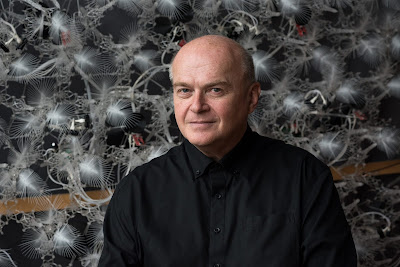Hylozoic Man
I watched with great interest Philip Beesley talk at Carnegie Mellon University. It reminded me of how much I owe to him, to the point of dedicating a good part of my master's thesis to his work. Beesley is a mix of Oskar Schlemmer - for his multidisciplinarity, ranging from fashion design to architecture - and George Gurdjieff - for his quasi-mystical character. It is amazing how he resumes some of the discussions of art history, such as those that separated organic and geometric sculptures, vitalism versus mechanism, etc. And, while the ancient sculptors valued the "synthetic realization of the mass ponderability of the object" (Jack Burnham), Beesley goes further and speaks of its “disposition”, elevating it to the quasi-organic category, or revealing the way in which technical objects are nothing more than "organized inorganic matter" (Bernard Stiegler). Of course, there are ambiguities, such as when he updates the Vitruvian ‘triad’, transforming firmitas into "compartment", a word that denotes closure. I may not have been able to achieve the ideal reasoning, but I see compartment as something other than open, unbound. Or perhaps the idea of a compartment is included in a new architectural paradigm, in which you start with a temporary compartment that unfolds in other compartments, less closed, but with greater capacity for exchanging with the environment. This in fact goes against the reductionist paradigm, of reducible and ultra-basic objects, such as those designed by Dieter Rams. Beesley's concept world is very rich, because he manages to recover the notion of clinamen (Lucretius) and associate it with quantum foam! An excellent presentation. I was unable to see the Q&A section because the sound was not very good. I hope Beesley's bold rhetoric resonated with the linear materialistic nerds in the audience.



